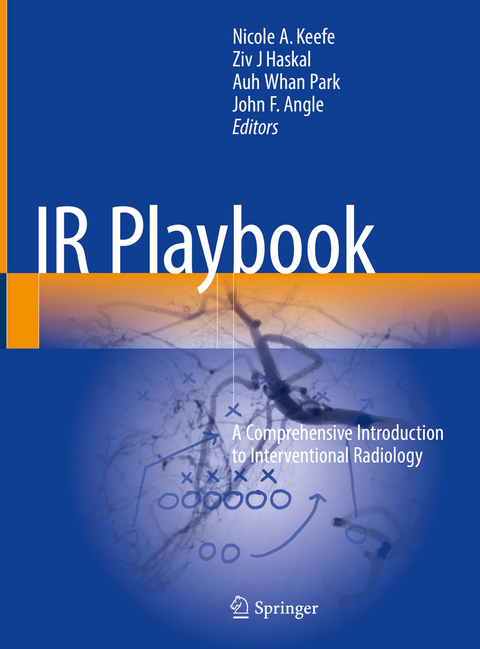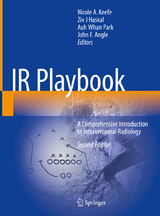
IR Playbook
Springer International Publishing (Verlag)
978-3-319-71299-4 (ISBN)
- Titel erscheint in neuer
- Artikel merken
This textbook offers a comprehensive guide to interventional radiology (IR) for medical students, residents, nurse practitioners, physician assistants, and fellows. IR is constantly evolving to meet the growing demands of patient care by applying cutting-edge technology to minimally invasive image-guided procedures. A dynamic specialty, interventional radiology has gained significant traction and interest in recent years, with combined IR/DR residencies rising to meet the increasing demand. This book addresses this growing need for a reference in IR, allowing students to gain a solid foundation to prepare them for their careers.
The book is divided into two main sections, with many images and key point boxes throughout that offer high-yield pearls along with the specific How To's necessary for practice. The first section is designed to give readers an introduction to IR, including radiation safety, commonly used devices, patient care, and anatomy.The second portion divides into sections covering major body areas, diseases, conditions, and interventions. These chapters cover procedures including pathophysiology, indications for treatment, as well as alternative treatments before delving into interventional therapy. IR Playbook gives medical students, residents, and trainees a full perspective of interventional radiology.
Nikki A. Keefe, MD is a Resident in the Department of Radiology and Medical Imaging at the University ofVirginia. Ziv J Haskal, MD, FSIR, FAHA, FACR FCIRSE, FBSIR is a world renowned tenured Professor of Radiology and Interventional Radiology Fellowship Director at the University of Virginia, Department of Medical Imaging. Auh Whan Park, MD is an associate professor in the Division of Vascular and Interventional Radiology in the Department of Radiology and Medical Imaging at the University of Virginia. John F. Angle, MD is the Director of the Division of Vascular and Interventional Radiology in the Department of Radiology and Medical Imaging at the University of Virginia.
Part I. Radiology Basics.- Chapter 1. Evolution of IR Training.- Chapter 2. Simulation Training in Interventional Radiology.- Chapter 3. Radiation Safety.- Chapter 4. Tools of the Trade.- Chapter 5. Patient Care in IR.- Chapter 6. The IR Roadmap: Vascular Anatomy Overview.- Chapter 7. Introduction to Cross-sectional Imaging.- Part II. Vascular Access.- Chapter 8. Vascular Access Techniques and Closure Devices.- Chapter 9. Central Venous Access.- Part III. Venous Disease.- Chapter 10. Venous Thromboembolism: Deep Venous Thrombosis and Pulmonary Embolism.- Chapter 11. IVC Filters.- Chapter 12. Dialysis Fistulae and Grafts.- Chapter 13. Pelvic Congestion Syndrome.- Chapter 14. Varicocele.- Chapter 15. Varicose Veins.- Chapter 16. Vascular Malformations.- Part IV. The Aorta.- Chapter 17. Abdominal and Thoracic Aortic Aneurysms.- Chapter 18. Aortic Dissection.- Chapter 19. Endoleak.- Chapter 20. Traumatic Aortic Injury.- Part V. Thoracic Interventions.- Chapter 21. Bronchial ArteryEmbolization.- Chapter 22. Pulmonary Angiography: Pulmonary Arteriovenous Malformation and Pseudoaneurysm.- Chapter 23 Lymphatic Interventions.- Part VI. Abdominal/Pelvic Arterial Interventions.- Chapter 24. Mesenteric Ischemia.- Chapter 25. Visceral Aneurysms.- Chapter 26. Renal Artery Stenosis.- Chapter 27. GI Bleeding.- Chapter 28. Uterine Artery Embolization.- Chapter 29. Prostate Artery Embolization.- Part VII. Lower Extremity Interventions.- Chapter 30. Aortoiliac Disease.- Chapter 31. Infrainguinal Disease.- Part VIII. Trauma.- Chapter 32. Visceral and Solid Organ Trauma.- Chapter 33. Pelvic and Extremity Trauma.- Part IX. Interventional Oncology.- Chapter 34. Transarterial Chemoembolization.- Chapter 35. Transarterial Radioembolization (TARE).- Chapter 36. Liver Ablation.- Chapter 37. Lung, Kidney, and Bone Ablation.- Part X. Hepatobiliary Disease.- Chapter 38. Transjugular Intrahepatic Portosystemic Shunt (TIPS) and Portal Hypertension.- Chapter 39. Balloon-occluded Transvenous Obliteration for Gastric Varices.- Chapter 40. Biliary Drainage.- Part XI. Biopsies, Drainage and Enteric Access.- Chapter 41. Biopsy Techniques.- Chapter 42. Ascites and Pleural Effusion.- Chapter 43. Obstructive Uropathy and Hydronephrosis.- Chapter 44. Enteric Access and Feeding Tubes.- Part XII. Neuro IR.- Chapter 45. Stroke.- Chapter 46. Cerebral Angiography: Aneurysms.- Chapter 47. Cerebral Angiography: Arteriovenous Malformations and Dural Arteriovenous Fistulae.
"This textbook is intended to provide a sufficient level of resolution to acquaint both medical students and resident physicians with the field of interventional radiology (IR). ... readable prose, high-quality radiologic images, and easy-to-understand diagrams making concepts accessible to novice trainees. Throughout the book there are convenient 'How To' text boxes that contain concise descriptions of procedures in a stepwise fashion." (Samuel Armstrong, Radiology, Vol. 3 (1), 2019)
"This is a high-quality, educational book presented in an excellent manner to appeal to medical students and radiology residents. The detailed presentation of the information makes the book a fundamental resource for residents, and it fills a void in interventional radiology books dedicated specifically to radiology trainees." (Daniel Hynes, Doody's Book Reviews, October, 2018)
| Erscheinungsdatum | 21.06.2018 |
|---|---|
| Zusatzinfo | XIX, 543 p. 486 illus., 343 illus. in color. |
| Verlagsort | Cham |
| Sprache | englisch |
| Maße | 210 x 279 mm |
| Gewicht | 2232 g |
| Themenwelt | Medizinische Fachgebiete ► Radiologie / Bildgebende Verfahren ► Radiologie |
| Schlagworte | Interventional Radiology • Nuclear Medicine • pathophysiology • Radiology • Ultrasound |
| ISBN-10 | 3-319-71299-3 / 3319712993 |
| ISBN-13 | 978-3-319-71299-4 / 9783319712994 |
| Zustand | Neuware |
| Informationen gemäß Produktsicherheitsverordnung (GPSR) | |
| Haben Sie eine Frage zum Produkt? |
aus dem Bereich



